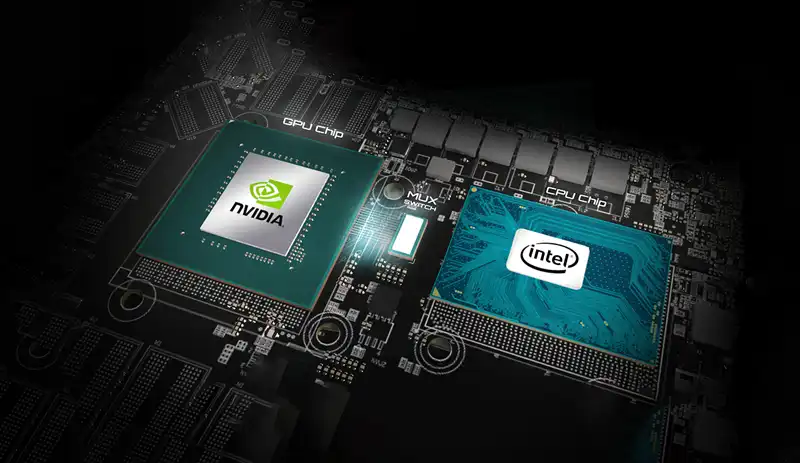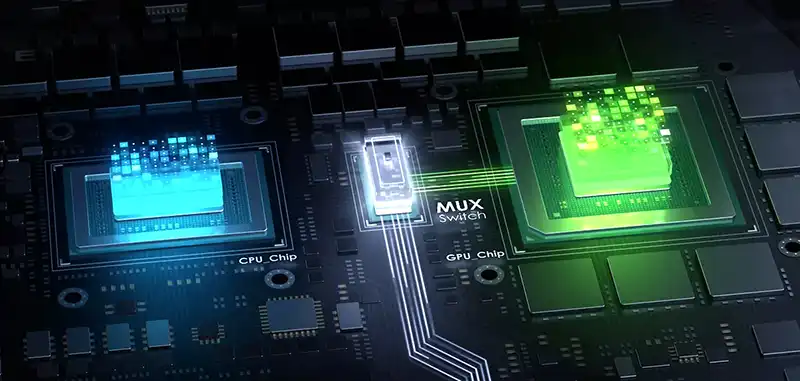You can also be interested in these:
- AMD FidelityFX Super Resolution 2.2 reinventing the game
- The history of RPG and why it is beloved by many
- The most costly Dota 2 types of equipment for tournaments
- The most successful academic lineups in CS:GO eSports
You may have heard about the MUX switch or MUX Switch before. This technology can be found in new gaming laptops and can offer increased performance at the cost of faster battery consumption. In this article, we will take a closer look at how this technology works and how you can utilize it.

What is NVIDIA Optimus (MSHybrid)?
Many gaming laptops come equipped with two GPUs. The first is the iGPU, which is integrated into the Intel or AMD processor. The second is the discrete graphics or dGPU, which could be a dedicated graphics card like NVIDIA GeForce, AMD Radeon, or Intel Arc.
Some operating systems allow for the use of one GPU over the other depending on the task at hand. For example, the iGPU can be used for lighter workloads while the dGPU can be used for heavier workloads such as video games.
It is worth noting that the dGPU is more powerful than the iGPU but also consumes considerably more energy. This means that if it is always in use, the battery life will be lower.
On the other hand, the iGPU has lower performance but also lower battery consumption. Therefore, the idea behind this technology is to use the iGPU to save battery and switch to the dGPU when higher performance is required. This is similar to what happens with heterogeneous CPU architectures with E-Cores and P-Cores, or big.LITTLE.
So, what NVIDIA Optimus or similar technologies do is that they use the iGPU when you are working normally, which is sufficient, and switch to the dGPU when you open a video game or other software that requires intensive use of the GPU.
Could it create a bottleneck?
It’s important to note that when you’re running a video game, for example, the frames will be generated in the dGPU as we mentioned earlier, but they are first sent through the iGPU before reaching the screen. This means that the iGPU will act as a significant bottleneck, which is why disabling technologies like Optimus can lead to improved gaming performance.
In some cases, the increase in FPS could reach up to 17%, which is a significant boost in performance.
What is a MUX switch?
Now that we understand the technologies that use one or the other GPU in systems with two graphics cards, it’s time to explore the MUX switch or MUX Switch. This multiplexer allows you to manually enable or disable the integrated graphics, i.e., the iGPU.
It does this by physically changing the connection between the GPU and the screen, which prevents technologies like Optimus from creating bottleneck problems. However, to benefit from this improvement, the laptop must have this hardware switch implemented physically.
Disabling the iGPU through the device manager of your operating system is not enough, as it doesn’t change the way images are passed to the screen through the iGPU, which is physically connected to the iGPU inside your laptop. MUX Switch allows you to switch between the iGPU/dGPU and the screen.

Thus, by using MUX Switch, the integrated graphics, or iGPU, will no longer be accessible. They will not appear in the device manager, and only discrete graphics or dGPU will be available. As a result, the image will go directly from the dGPU to the screen without having to pass through the iGPU, which means there won’t be any performance issues.
Additional functions of MUX Switch
In some cases, MUX Switch can perform additional functions. For example, with Optimus enabled, technologies like ShadowPlay or G-Sync couldn’t be used, but with MUX Switch enabled, they will be available because the dGPU is directly connected to the screen without passing through the iGPU, which takes care of these functions.
How do I know if my laptop has MUX Switch?
This is a common question among gaming laptop users. To find out, you should visit the official website of your laptop’s brand and check the specifications or download the manual of your specific model. This way, you can determine whether or not MUX Switch is present. It should be noted that most popular gaming equipment brands typically include it.
Advantages of MUX Switch
Without MUX Switch, the gaming laptop, no matter how powerful its dGPU is, will always be limited because it has to pass through the iGPU, which is physically connected to the screen of your laptop. In other words, you are forced to use technologies like Optimus with the performance issues it presents, as mentioned earlier.
Additionally, it is true that MUX Switch gaming laptops used to be expensive, but they have become increasingly common and affordable over the years. However, it is important to note that some high-end gaming laptops do not have this feature. For instance, ASUS does not include it in some of its Strix or Zephyrus models.
We believe it is an excellent option if you can afford one of these devices. With MUX Switch, you can choose to use either GPU and achieve maximum gaming performance without any bottlenecks. Nevertheless, keep in mind that when you use the dGPU, the battery will be affected, and the autonomy will significantly decrease. This means that you will have to charge it more frequently, although it is not a problem for those who keep their laptops constantly connected to the adapter.
I don’t have a MUX switch; can I bypass Optimus?
Another frequently asked question by users is whether they can disable Optimus to avoid performance issues and increase gaming performance if their gaming laptop lacks MUX Switch. Well, it is worth noting that in such cases, it is best if your laptop has a video output, such as HDMI, to connect an external display. If it is connected to the dGPU and not the iGPU, then you can enjoy maximum performance by using an external monitor. However, you should check your laptop’s specifications to know which GPU that video output depends on.
NVIDIA’s Advanced Optimus
To address issues with Optimus, NVIDIA developed a new technology known as Advanced Optimus, which is essentially an automatic MUX Switch. This improvement eliminates the need for a system restart to switch between the iGPU and dGPU. It is an intelligent software that uses the iGPU-Screen when the laptop is being used for lighter workloads, such as browsing the internet or other tasks. When heavy graphics workloads such as video games are being used, it switches to the dGPU-Screen.
This solution is clearly preferable to having to manually restart the system every time a switch is required. This is particularly true for some devices like the Dell G15, which require users to access the BIOS/UEFI to make the switch as it can only be done from there without a software interface.
Conclusion
Although NVIDIA’s Advanced Optimus is considered the most practical solution because of the dynamic change, it is not yet widely available in many laptops, while MUX Switch is somewhat more widespread at present.
More stories like this
- AMD FidelityFX Super Resolution 2.2 reinventing the game
- The history of RPG and why it is beloved by many
- The most costly Dota 2 types of equipment for tournaments
- The most successful academic lineups in CS:GO eSports
- OSRS: Get ready for the Tombs of Amascut
- eSports careers for those who can’t play